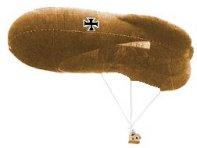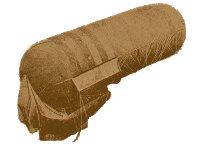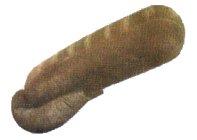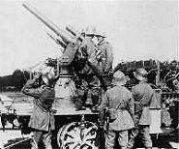|
|

|
Observation Balloons

The Germans made excellent use of observation balloons in
several configurations. An early variety made by Parseval-Sigsfeldand
called "Drachen", had a single fin, low centre, and was totally
cylindrical, with rounded ends. The British called them sausages, for
obvious reasons. The balloon's shape gave it another nickname, "Nulle" or
"Testicle".
The Caquot was tear-drop shaped, with three stabilizing
fins. The Germans used a copy of a French Caquot, the designation was
"Type Ae 800" for Achthundert English 800 which was a reference to the
cubic meter capacity English, the reason for this being the design was
stolen from a captured British balloon design. The improved Caquot could
ride higher, and fly in higher winds than the Parseval-Sigsfeld, so it
quickly replaced the Drachen, even among the Luftschiffertruppen.

Pictured above is a copy of a French Caquot, the German designation was
"Type Ae
The observer suspended in the wicker basket typically
had a wireless set, binoculars and one or two long-range, cameras with
him. Their job was to observe actions on the front and behind it, to spot
enemy troop movements, unusual activity of any sort, and to call down
artillery fire onto any worthy targets. They were targets of great
importance to the British HQ, especially before any sort of infantry
action, so squadrons were frequently ordered to target balloons.

Shown above is an example of a typical British designed observation
balloon.
This was especially risky as they were well guarded
with AA guns, long-range machine guns and a fighter Screen. Getting to the
balloon was easy, shooting it up was difficult and getting away was very
difficult. It required good nerves, quick reactions, and an all round good
pilot to fight their way through the defences, hit the balloon before it
is pulled down and then get away again. It was a rule of thumb with
British pilots to never go after balloons below 1,000 feet, the AA and mg
fire was too dangerous. The balloons could be pulled down very quickly as
they were tethered to a motorized winch, so that once a fighter was
spotted the balloon could be down in under a minute.

The British called them sausages, for obvious reasons. The balloon's shape
gave it another nickname, "Nulle" or "Testicle".
The secret was to sneak up on them some how. As the
balloons were filled with hydrogen they burned easily once they were
pierced with tracer bullets or bullets especially designed for Zeppelins.
The first balloon-busters fired Le Prieur rockets. The French introduced
these during the Verdun fighting of 1916. Incendiary bullets replaced
rockets beginning in 1917.
The balloon observers were the only people routinely
outfitted with parachutes, which had been available since 1915. The
parachutes had a failure rate just high enough to ensure that observers
jumped only in dire emergencies. By the war's end 241 German observation
balloons had been shot down.

A German 75-mm Anti Aircraft Battery stands guard near an observation
balloon. The German gun crew were known to mix in incendiary rounds
called "flaming onions," this was ammunition specifically designed for
balloon-busters. These threw up great balls of fire, distracting all but
the most determined pilots.
|
|
|
